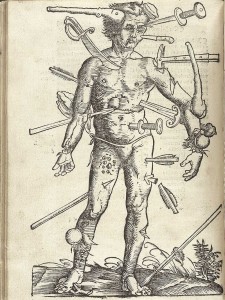A Hannibal Lecter textbook murder
In one example of a web forum, art crimes are identified and an emoji of Edvard Munch’s The Scream is used to rate the perceived severity of each offence; as if such an appropriation were not itself a crime. There are endless instances of crimes against art with as broad a stroke as theft, damage and intellectual property infringements. Rarer discussions surround works of art that have been used to inspire crime. Dr Hannibal Lecter is one such individual who uses art to inform murder.
Described as Hannibal the Cannibal, a psychiatrist and murderer, he is one of the most famous and feared criminals of the 20th century, albeit a fictional one. A terrifying protagonist of novels, film and television, he first appears in the novel Red Dragon (1981), a title which refers to a William Blake drawing. Here we discover how he was exposed by detective Wil Graham and then incarcerated in an institution for the criminally insane: ’”It was Sunday. He saw patients on Sunday…He saw me right away. We were talking and he was making this polite effort to help me and I looked up at some very old medical books on the shelf above his head. And I knew it was him.’” [1] Wil Graham had made a connection between the medical books, a medical textbook illustration, and Dr Lecter’s sixth victim.
It was the medical illustration known as Wound Man that was Hannibal Lecter’s undoing. Wound Man appeared in late medieval anatomy texts as a chart or encyclopaedic diagram of all the injuries a body may sustain. [2] He then evolved into printed form until the seventeenth century before arriving centuries later in popular fiction. He likewise appears in facsimile versions in the University Library collections. He is a sort of ubiquitous figure experiencing all the blights of humanity. He exhibits such a prescriptive pattern of wounds and ailments as to be recognisable to detective Graham when he sees them replicated on Dr Lecter’s former patient and victim.

Depictions of Wound Man do differ through texts and centuries, and medieval versions for example, show bite wounds from a dog, snake and insects whereas the Renaissance Wound Man exhibits injuries more reflective of the results of war. He has been pierced by arrows, slashed by blades and bludgeoned with clubs. A woodcut version for the battle surgeon which appears in Hans von Gersdorff’s Feldbuch der Wundarzney (Field book of surgery) in 1517 incorporates a new technological advance as his bones are smashed by cannon balls; the use of the cannon in warfare developed in sixteenth century Europe. A Wound Man of the 21st century may well exhibit smartphone related injuries.
Wound Man may himself have been based on the traditional portrayals of St Sebastian, an early Christian martyr who is customarily depicted in art fatally wounded by arrows. [3] The Baillieu Library Print Collection contains images of the legend by Albrecht Dürer seen by the engraving St Sebastian at the Column (c.1501).

Hannibal Lecter’s knowledge of art and culture is extensive and it is one of the chief motivations of his character. His murders are executed with a distinct sinister emphasis on taste and artistry. After he escaped from custody, he despatched the former occupant and reinvented himself as the curator of the Palazzo Capponi in Florence. Later forced to flee after his discovery, his is regretful as ‘There were things in the Palazzo Capponi that he would have liked to find and read. He would have liked to play the clavier and perhaps compose; he might have cooked for the Widow Pazzi, when she overcame her grief.’ [4]
The interaction of art and crime is an elaborate and fascinating subject, and the Hannibal Lecter textbook murder is just one illustration designed to leave you hanging.
Kerrianne Stone (Curator, Prints)
Notes
[1] Thomas Harris, Red Dragon, 2000, Bantam Dell, New York, p. 70
[2] Julie Anderson, The art of medicine: over 2,000 years of images and imagination by Julie Anderson, Emm Barnes, and Emma Shackleton; foreword by Antony Gormley, Chicago Press, 2011, p. 196
[3] Cynthia Marshall, ‘Wound-man: Coriolanus, gender, and the theatrical construction of interiority,’ in Feminist readings of early modern culture: emerging subjects edited by Valerie Traub, M. Lindsay Kaplan, Dympna Callaghan, Cambridge [England]; Cambridge University Press, 1996, p. 103
[4] Thomas Harris, Hannibal, 2000, Bantam Dell, New York, p.239
Categories
- Uncategorised
- Prints
- Special Collections
Leave a Reply